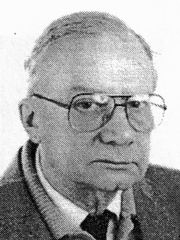

Camille Sándorfy

Born December 9, 1920 in Budapest, Hungary. Emeritus Professor of Chemistry, Université de Montréal, Québec, Canada.
Fellow of The Royal society of Canada (1967). K.W. Killam Memorial Scholarship (1978-80). Herzberg medal (1980). Prix Marie-Victorin du Québec (1982). Medal of the Chemical Institute of Canada (1983). Dr. honoris causa Université de Moncton, Canada (1986); University of Szeged, Hungary (1988). Vice-president of the European Academy of Arts, Sciences, and Humanities. J. Heyrovsky Gold Medal of the Czech Academy of Sciences (1993). External member of the Hungarian Academy of Sciences (1993) Officer of the Order of Canada (1995). Membre de l'Ordre National du Québec (1995).
Author of:
"The Application of Infrared and Raman Spectrometry to the Elucidation of Molecular Structure", with R. N. Jones. Weissberger's Technique of Organic Chemistry, Vol. 9, Interscience, 1956, pp. 247-580. (Translated into Russian.)
"Les Spectres Électroniques en Chimie Théorique", Ed. Revue d'Optique, Paris 1959. (Translated into German and Japanese)
"Electronic Spectra and Quantum Chemistry, Prentice-Hall, inc. (1964).
"Semiemprical Wavemechanical Calulations on Polyatomic Molecules, with R. Daudel, Yale University Press, 1971.
"The Role of Rydberg States in Spectroscopy and Photochemistry." (Editor and Co-author.) Kluwer Academic Publishers, 1999.
"Les Spectres Électroniques en Chimie Théorique", Ed. Revue d'Optique, Paris 1959. (Translated into German and Japanese)
"Electronic Spectra and Quantum Chemistry, Prentice-Hall, inc. (1964).
"Semiemprical Wavemechanical Calulations on Polyatomic Molecules, with R. Daudel, Yale University Press, 1971.
"The Role of Rydberg States in Spectroscopy and Photochemistry." (Editor and Co-author.) Kluwer Academic Publishers, 1999.
Important Contributions:
- In quantum chemistry — the first molecular orbital calculations on polyatomic s-electron systems, in particular saturated hydrocarbons. The first molecular orbital calculations on the acidity and basicity of excited aromatic molecules.
- In electronic spectroscopy — extensive work in the far-ultraviolet. Absorption spectra (from 50000 to 80000 cm-1) of saturated hydrocarbons and their substituted derivatives; higher transitions of olefins, aromatic molecules and heteroatomic molecules.
- In vibrational spectroscopy — extensive experimental work on hydrogen bonded systems in the infrared and in the near-infrared (overtone region). The effect of hydrogen bonding on the anharmonicity of vibrations.
- Applications of biological interest — infrared work on the protonation of retinylidene Schiff bases modeling the chromophore of rhodopsins. Infrared model work on the possible role of hydrogen bonding in the mechanisms of anaesthesia.
An obituary can be found at
http://www.prixduquebec.gouv.qc.ca/recherche/desclaureat.php?noLaureat=164.